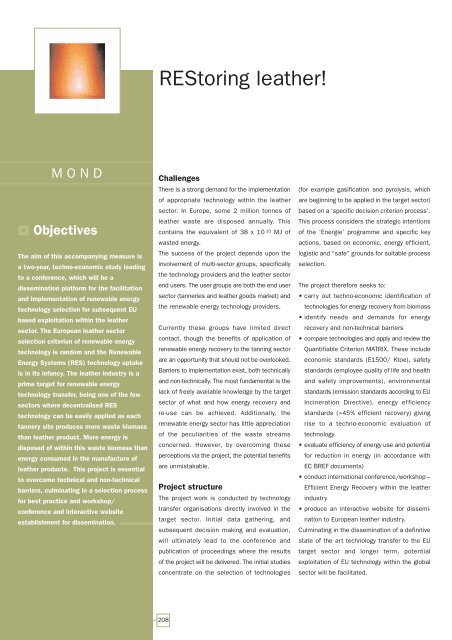European Bio-Energy Projects
European Bio-Energy Projects
European Bio-Energy Projects
You also want an ePaper? Increase the reach of your titles
YUMPU automatically turns print PDFs into web optimized ePapers that Google loves.
MOND<br />
Objectives<br />
The aim of this accompanying measure is<br />
a two-year, techno-economic study leading<br />
to a conference, which will be a<br />
dissemination platform for the facilitation<br />
and implementation of renewable energy<br />
technology selection for subsequent EU<br />
based exploitation within the leather<br />
sector. The <strong>European</strong> leather sector<br />
selection criterion of renewable energy<br />
technology is random and the Renewable<br />
<strong>Energy</strong> Systems (RES) technology uptake<br />
is in its infancy. The leather industry is a<br />
prime target for renewable energy<br />
technology transfer, being one of the few<br />
sectors where decentralised RES<br />
technology can be easily applied as each<br />
tannery site produces more waste biomass<br />
than leather product. More energy is<br />
disposed of within this waste biomass than<br />
energy consumed in the manufacture of<br />
leather products. This project is essential<br />
to overcome technical and non-technical<br />
barriers, culminating in a selection process<br />
for best practice and workshop/<br />
conference and interactive website<br />
establishment for dissemination.<br />
REStoring leather!<br />
Challenges<br />
There is a strong demand for the implementation<br />
of appropriate technology within the leather<br />
sector. In Europe, some 2 million tonnes of<br />
leather waste are disposed annually. This<br />
contains the equivalent of 38 x 10 10 MJ of<br />
wasted energy.<br />
The success of the project depends upon the<br />
involvement of multi-sector groups, specifically<br />
the technology providers and the leather sector<br />
end users. The user groups are both the end user<br />
sector (tanneries and leather goods market) and<br />
the renewable energy technology providers.<br />
Currently these groups have limited direct<br />
contact, though the benefits of application of<br />
renewable energy recovery to the tanning sector<br />
are an opportunity that should not be overlooked.<br />
Barriers to implementation exist, both technically<br />
and non-technically. The most fundamental is the<br />
lack of freely available knowledge by the target<br />
sector of what and how energy recovery and<br />
re-use can be achieved. Additionally, the<br />
renewable energy sector has little appreciation<br />
of the peculiarities of the waste streams<br />
concerned. However, by overcoming these<br />
perceptions via the project, the potential benefits<br />
are unmistakable.<br />
Project structure<br />
The project work is conducted by technology<br />
transfer organisations directly involved in the<br />
target sector. Initial data gathering, and<br />
subsequent decision making and evaluation,<br />
will ultimately lead to the conference and<br />
publication of proceedings where the results<br />
of the project will be delivered. The initial studies<br />
concentrate on the selection of technologies<br />
208<br />
(for example gasification and pyrolysis, which<br />
are beginning to be applied in the target sector)<br />
based on a ‘specific decision criterion process’.<br />
This process considers the strategic intentions<br />
of the ‘Energie’ programme and specific key<br />
actions, based on economic, energy efficient,<br />
logistic and “safe” grounds for suitable process<br />
selection.<br />
The project therefore seeks to:<br />
• carry out techno-economic identification of<br />
technologies for energy recovery from biomass<br />
• identify needs and demands for energy<br />
recovery and non-technical barriers<br />
• compare technologies and apply and review the<br />
Quantifiable Criterion MATRIX. These include<br />
economic standards (E1500/ Ktoe), safety<br />
standards (employee quality of life and health<br />
and safety improvements), environmental<br />
standards (emission standards according to EU<br />
Incineration Directive), energy efficiency<br />
standards (>45% efficient recovery) giving<br />
rise to a techno-economic evaluation of<br />
technology.<br />
• evaluate efficiency of energy use and potential<br />
for reduction in energy (in accordance with<br />
EC BREF documents)<br />
• conduct international conference/workshop –<br />
Efficient <strong>Energy</strong> Recovery within the leather<br />
industry<br />
• produce an interactive website for dissemination<br />
to <strong>European</strong> leather industry.<br />
Culminating in the dissemination of a definitive<br />
state of the art technology transfer to the EU<br />
target sector and longer term, potential<br />
exploitation of EU technology within the global<br />
sector will be facilitated.

















